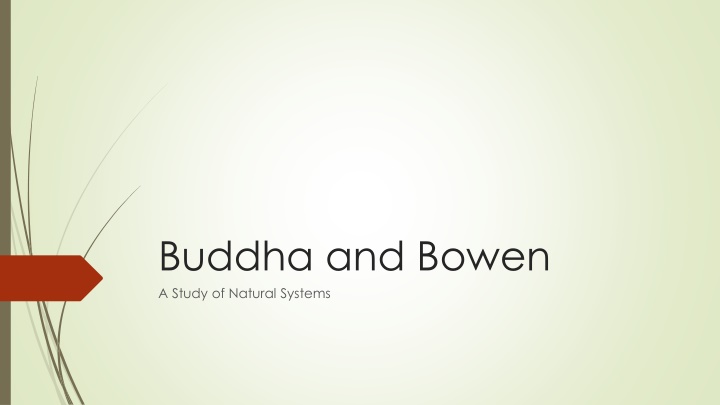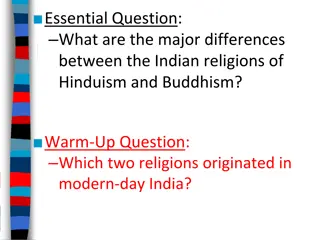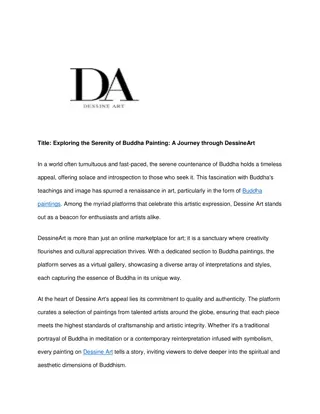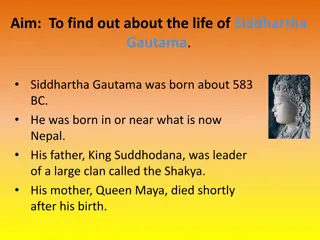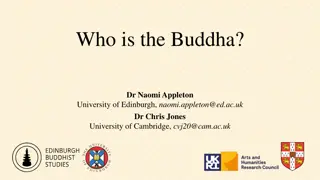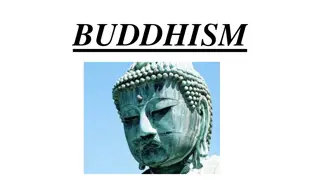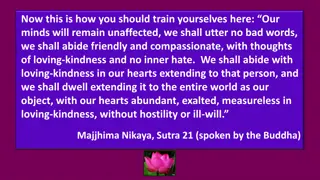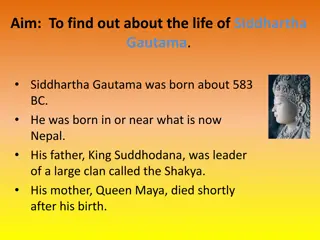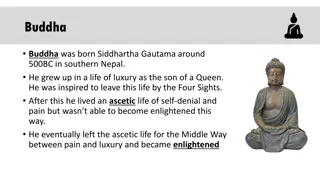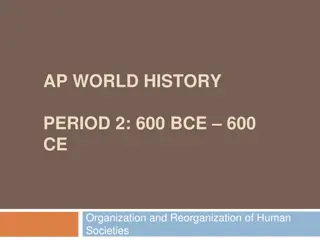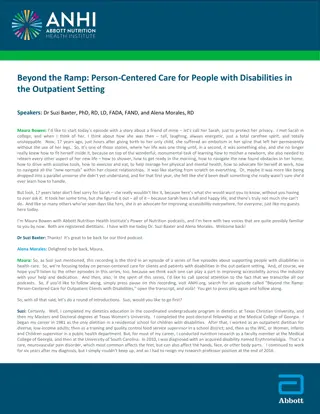Buddha and Bowen
This study delves into the convergence between Bowen theory and ancient Buddhist teachings, exploring the compatibility and possible contributions to psychology. It examines the hypothesis that Bowen's insights align with Buddha's discoveries, highlighting the challenges in comparing Buddhism and psychology. The discussion encompasses concepts like equanimity, differentiation of self, and the application of Systems Thinking to post-sectarian Buddhism. The theory of Vipassan is also analyzed in relation to generating testable hypotheses and scientific exploration.
Download Presentation

Please find below an Image/Link to download the presentation.
The content on the website is provided AS IS for your information and personal use only. It may not be sold, licensed, or shared on other websites without obtaining consent from the author.If you encounter any issues during the download, it is possible that the publisher has removed the file from their server.
You are allowed to download the files provided on this website for personal or commercial use, subject to the condition that they are used lawfully. All files are the property of their respective owners.
The content on the website is provided AS IS for your information and personal use only. It may not be sold, licensed, or shared on other websites without obtaining consent from the author.
E N D
Presentation Transcript
Buddha and Bowen A Study of Natural Systems
Preface: Traditions The collapse of Buddhism Study of the Buddha requires differentiation of traditions. Probably not acceptable by all Buddhist traditions. Probably not acceptable by all non-Buddhist traditions But that s what science is for. Study probably only applies to pre-sectarian traditions. Probably grossly incompatible with Mah y na Japanese (Zen Buddhism), Chinese (Chen, etc) Vajray na (Tibetan Buddism) Aaalmoooost, but not quite Therav da. Non-sectarian; Pure dhamma; A science of mind and matter.
Preface: Project Goals Explore convergence with Bowen theory. Consilience between Bowen and an ancient historical figure? Systems Thinking: Assumes/researches relation of all things in universe. Mutual-causality VS linear-causality. Process V.S. content - Affect regulation V.S psyche and metaphor Equanimity == intracranial/intrasomatic differentiation? (Differentiation of Self?) Explore one way to make Vipassan more accessible to science. Differentiate between science V.S. religion.
Hypothesis Hypothesis: Bowen got some things right which may have unique compatibility with the Buddha s discoveries. What is in common may be what is missing from psychology. Challenges comparing Buddhism and psychology. Largely intellectual; originating from human mind/culture. Missing rigorous meditation practice. Self VS no-self. Post-modernism: no objective truth. Challenges in post-sectarian Buddhism to Systems Thinking Middle path as homeostasis; (I assert status-quo != purification) Post-modernism: no objective truth (not realist paradigm)
At Least Two Natural Systems 1) Mind/Body system Has emotional system: probably an integral part of family emotional system. Sankh ras: normalized symptoms of emotional process. Focus is on process of reactivity, not content of sankh ras. Symptoms are result of reactivity, outlined in process of 1) consciousness, 2) cognition/recognition, 3) evaluation, 4) reaction. 2) Family System Content: normalizes symptoms of emotional process. Focus is on process of reactivity, not content of symptoms. Societal System
Vipassan theory Implies collection of concepts which generate testable hypotheses toward scientific fact. Hypothesis: An educated guess about a tiny piece of the puzzle. (Bowen) Concept: A larger piece of the total puzzle. (Bowen) Scientific fact: When sufficient data proves accuracy of theory. VT avoids religion or spiritual labels which can be poorly defined. Buddha and paticca-samupadda ( scientific theory of suffering): Similar to Newton and gravity Similar Einstein and relativity Implies modernist/realist paradigm Implies generation of testable hypotheses? Implies possibility of accepted science?
Theory of Suffering: feedback loop of mind body mind body mind
Theory of Suffering (2ndNoble Truth) Dependent Origination/Interdependent Origination/Dependent Co-Arising/etc. 1) ignorance 2) reaction 3) consciousness 4) name/form 5) sense organs 6) contact 7) sensation 8) craving (compulsion, not yet acted) 9) clinging (acting out craving) 10) becoming (rebirth) 11) sickness, old age, death 1) ignorance Defines feedback loop of Mind / body Occurs trillions of times per second Programmatic behavior of a complex system Not compatible with many traditions which view process as once per life-time.
Goal of Vipassan Eradicate suffering in all its forms (3rdNoble Truth), by: Seeing mind/body as complete emotional unit. No symptom, sensation, thought is an isolated phenomena. Develop literally simultaneous awareness of entire body. Only possible by observing sensation without reacting. Move beyond all blind spots (1-to-1 relationships with all body parts?). Dullness in mind only feels gross sensations Fine detail of complex sensations is misconstrued as a single symptom. Prerequisite: highly developed fine attention. >= Structured 10+ day course of continuous practice.
Goal of Vipassan Loss of detail into gross sensations (i.e. symptoms) == IGNORANCE Ignorance : first step in dependent origination. Ignorance of reality. Ignoring multitude of variables influencing outcome.
Goal of Vipassan Example: Emotional system connects imbalance in foo, hip, lungs with allergic reaction. Relieving pain in the back while sitting simply moves symptom somewhere else. Way out of suffering! (4thNoble Truth) Remain in contact without reacting, the system will reorganize.
Sensory Fuel Conscious/unconscious attention to anything other than the bodily sensations AKA lack of mindfulness pizza, movies, relationship drama, and free-trade organic kale chips External sensory modulates the internal life process Food for material sustenance. Information for programmatic (organizational) sustenance. Habituates dependence on environment.
Change: Sankhras are not fun Exhaustive categories of sankh ras enumerated as five enemies. Sensory desire I m hungry Ill-Will I m too angry Sloth-Torpor: I m too tired right now Restlessness-Worry: This is too boring Doubt: This process/practice is not for me
Change: Sankhras are not fun Example: Food fast Breaks down toxins. Internal processes become more auto-modulated. Builds resilience: physical and some mental But not ideal Why not ideal? The ascetic Buddha: been there, done that. Abandoned deprivation for the middle path (Jung s TF, anyone?) Discovered self-organizing principle AKA: The Dhamma (skt. dharma) - The information state of the universe.
Ideal Change (according to the Buddha) Attention is the decisive factor. Must be unbroken. Must be on body sensations, or mind/mental contents as bodily sensations. Must include entire body simultaneously. Must reach stage of total dissolution. No solidity anywhere Second-nature: every sensation is temporary no matter how difficult. Akin to seeing false threats as they are. Can be achieved within one or a couple of years, factors depending.
Ideal Change (according to the Buddha) Mind + mental contents comes later in practice Traditions differ here. Mind + mental contents occur via sensations. Vedan samosaran sabbe dhamma.
All Systems: Two Opposing Forces? Status Quo (suffering; 1st Noble Truth) Life is suffering Tension of counterbalancing forces == suffering. Encouraged by increased sensory fuel. Toward ideal organization (enlightenment) Mind + Body unit wants to organize toward health. Encouraged by decreased sensory fuel.
Bits of Consilience Ability to stay in contact with sensation (emotion) without reacting. Ability to think when stressed. Avoid backbiting speech. He who does not return anger in kind, has won the hard battle to win. Not for curing disease, but curing disease is a natural side-effect. Not a therapy for suffering but a way out of all suffering. Bowen: not symptom relief, but concepts which account for more variance than individual variables. Entire process is to work on self in order to serve others Entire focus is on one s own qualities, is selfish. Ability to serve others comes naturally. Mett (loving-kindness) comes naturally as result of practice.
